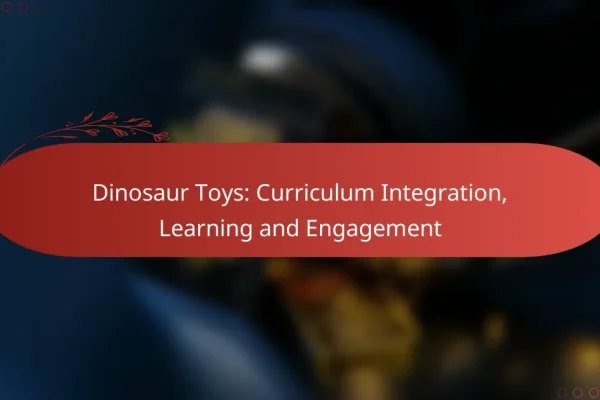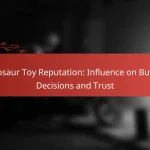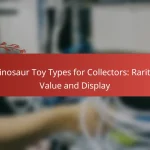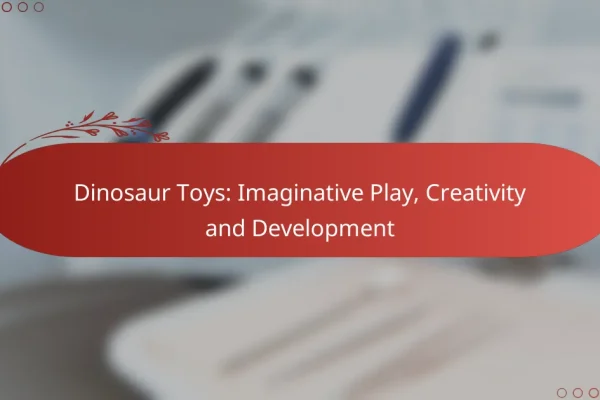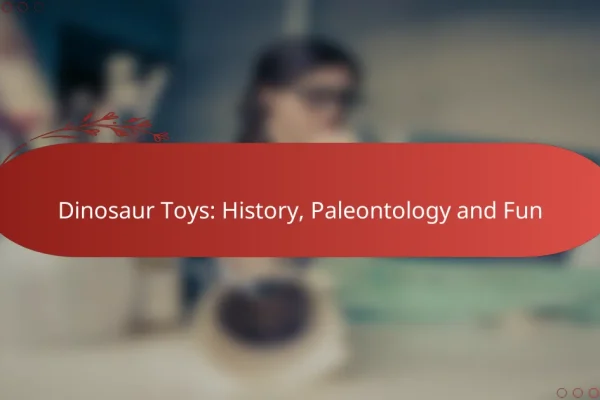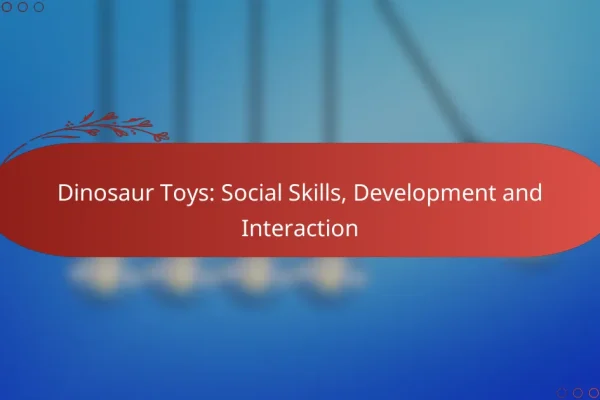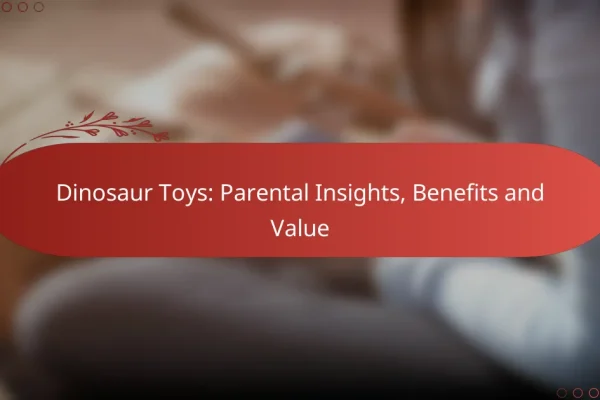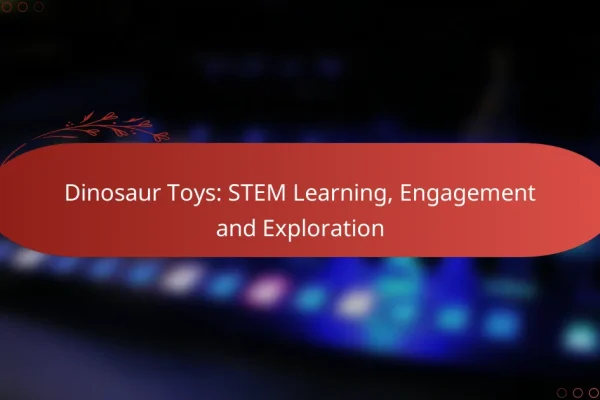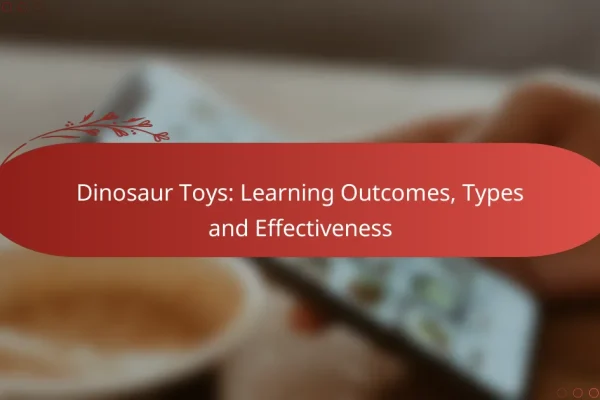How do dinosaur toys enhance learning in children?
Dinosaur toys enhance learning in children by promoting engagement through play, which fosters various developmental skills. These toys stimulate curiosity about prehistoric life while encouraging exploration and creativity.
Promote cognitive development
Dinosaur toys can significantly promote cognitive development by encouraging children to think critically and solve problems. For instance, when children engage in imaginative scenarios involving dinosaurs, they often create narratives that require logical sequencing and memory recall.
Playing with dinosaur figures can also introduce concepts like size, shape, and classification, helping children develop their reasoning skills. Activities such as sorting different dinosaur species can reinforce these cognitive abilities.
Encourage imaginative play
Dinosaur toys are excellent tools for encouraging imaginative play, allowing children to create their own stories and adventures. This type of play fosters creativity, as children invent scenarios that involve their dinosaur figures, enhancing their storytelling skills.
Imaginative play with dinosaurs can also help children explore emotions and social roles, as they often act out various characters and situations. This exploration is crucial for emotional development and understanding social dynamics.
Facilitate social interaction
Dinosaur toys facilitate social interaction by providing a common ground for children to play together. When children engage in cooperative play with dinosaur figures, they learn to share, negotiate, and collaborate, which are essential social skills.
Group play scenarios, such as creating a dinosaur park or a prehistoric scene, encourage teamwork and communication. These interactions can help children build friendships and develop their social networks.
Support fine motor skills
<pPlaying with dinosaur toys can support the development of fine motor skills as children manipulate the figures. Activities such as picking up, arranging, and moving dinosaurs require hand-eye coordination and dexterity.
Incorporating accessories like building blocks or play mats can further enhance these skills. For example, stacking blocks to create a dinosaur habitat requires precision and control, providing a fun way to practice fine motor abilities.
Introduce basic scientific concepts
Dinosaur toys can introduce children to basic scientific concepts, such as extinction, evolution, and the prehistoric environment. Through play, children can learn about different dinosaur species and their characteristics, fostering an early interest in science.
Parents and educators can enhance this learning by discussing topics like the food chain or geological time periods while children play. This contextual learning helps solidify scientific knowledge in an engaging manner.
What types of dinosaur toys are best for educational purposes?
The best dinosaur toys for educational purposes include interactive figurines, puzzles, building sets, and augmented reality apps. These toys engage children in learning about dinosaurs while promoting skills such as problem-solving, creativity, and critical thinking.
Interactive dinosaur figurines
Interactive dinosaur figurines often feature sounds, movements, or lights that enhance playtime. These toys can help children learn about different dinosaur species, their habitats, and behaviors through imaginative play. Look for figurines that come with educational materials or apps to deepen the learning experience.
When selecting interactive figurines, consider durability and safety standards, especially for younger children. Brands that comply with toy safety regulations, such as ASTM or EN71, are preferable.
Dinosaur puzzles
Dinosaur puzzles are excellent for developing spatial awareness and fine motor skills. They come in various difficulty levels, making them suitable for different age groups. Choose puzzles that depict various dinosaurs and include educational facts to enhance learning.
For younger children, opt for larger pieces made from safe materials. As children grow, consider more complex puzzles that challenge their problem-solving abilities and encourage teamwork when done in groups.
Dinosaur-themed building sets
Dinosaur-themed building sets allow children to construct their own dinosaur models, fostering creativity and engineering skills. These sets often come with instructions that teach children about dinosaur anatomy and the construction process. Look for sets that are compatible with other building toys for expanded play opportunities.
When purchasing building sets, check for age appropriateness and the complexity of the designs. Sets that encourage collaborative building can also enhance social skills and teamwork.
Augmented reality dinosaur apps
Augmented reality (AR) dinosaur apps provide an immersive learning experience by bringing dinosaurs to life through smartphones or tablets. Children can interact with 3D models, learn facts, and even explore virtual environments where dinosaurs lived. These apps often include games and quizzes to reinforce knowledge.
Ensure that any AR app is age-appropriate and has positive reviews regarding educational content. Monitor screen time to balance digital learning with hands-on play for a well-rounded educational experience.
How can parents choose the right dinosaur toys?
Parents can choose the right dinosaur toys by considering factors such as age appropriateness, educational value, safety standards, and durability. These elements ensure that the toys are not only enjoyable but also beneficial for children’s development.
Consider age appropriateness
Choosing dinosaur toys that match a child’s age is crucial for safety and engagement. Toys designed for younger children typically feature larger parts and simpler designs, while those for older kids may include intricate details and smaller pieces. Always check the manufacturer’s age recommendations to ensure the toy is suitable.
For instance, toys labeled for ages 3 and up often avoid small parts that could pose choking hazards. Parents should also consider the developmental stage of their child to select toys that stimulate learning and creativity.
Evaluate educational value
Dinosaur toys can offer significant educational benefits, such as enhancing knowledge about prehistoric life and fostering imaginative play. Look for toys that encourage storytelling, role-playing, or even scientific exploration, like dinosaur excavation kits.
Some toys come with educational materials or apps that provide facts about different dinosaur species, which can enrich a child’s learning experience. Selecting toys that promote curiosity and learning can make playtime both fun and informative.
Assess safety standards
Safety is paramount when selecting dinosaur toys. Parents should ensure that the toys comply with recognized safety standards, such as ASTM or EN71, which indicate they have been tested for harmful substances and safety hazards. Checking for certifications can provide peace of mind.
Additionally, avoid toys with sharp edges, small detachable parts, or toxic materials. Reading reviews and product descriptions can help identify safe options that meet these criteria.
Check for durability
Durability is an important factor when choosing dinosaur toys, especially for active play. Look for toys made from high-quality materials that can withstand rough handling. Plastic toys should be thick and sturdy, while plush toys should have reinforced seams.
Parents can also consider the warranty or return policy offered by the manufacturer. A good warranty can indicate confidence in the product’s durability, making it a safer investment for long-term use.
What are the benefits of dinosaur toys in early childhood education?
Dinosaur toys offer numerous educational benefits in early childhood education, enhancing learning through play. They engage children’s curiosity about science, history, and creativity, making complex concepts more accessible and enjoyable.
Enhance STEM learning
Dinosaur toys can significantly enhance STEM (Science, Technology, Engineering, and Mathematics) learning by sparking interest in these subjects. Children can explore concepts like paleontology, geology, and biology through imaginative play, which helps them grasp scientific principles in a fun way.
For example, kids can create their own dinosaur habitats, which introduces them to ecosystems and environmental science. Encouraging them to measure and compare the sizes of different dinosaurs can also foster basic math skills.
Foster creativity and expression
Dinosaur toys encourage creativity and self-expression as children invent stories and scenarios involving their favorite prehistoric creatures. This imaginative play allows kids to explore different narratives, enhancing their storytelling abilities and creative thinking.
Setting up a dinosaur-themed adventure or creating a dinosaur museum can help children express their ideas visually and verbally. Providing art supplies alongside dinosaur toys can further stimulate their creativity, allowing them to draw or craft their own dinosaur models.
Build vocabulary and language skills
<pPlaying with dinosaur toys can help build vocabulary and language skills in young children. As they engage in play, they learn new words related to dinosaurs, their characteristics, and their environments, enriching their language development.
Encouraging discussions about different dinosaur species, their habitats, and behaviors can enhance conversational skills. Reading books about dinosaurs while playing can also reinforce language skills and introduce new concepts in an engaging context.
How do dinosaur toys compare to other educational toys?
Dinosaur toys offer unique educational advantages compared to other types of toys by engaging children’s curiosity about prehistoric life and fostering imaginative play. They combine elements of science, history, and creativity, making them versatile tools for learning.
Unique thematic engagement
Dinosaur toys captivate children’s interest through their connection to a fascinating theme that blends adventure with education. This thematic engagement encourages imaginative play, allowing kids to create stories and scenarios that enhance their cognitive development.
For example, children can role-play as paleontologists, digging for dinosaur fossils or creating habitats for their toy dinosaurs. This type of play not only entertains but also promotes problem-solving skills and critical thinking.
Broader historical context
Using dinosaur toys introduces children to a broader historical context, helping them understand the timeline of Earth’s history and the evolution of life. This context can spark discussions about extinction, adaptation, and the environment.
Parents and educators can enhance this learning by incorporating books and documentaries about dinosaurs, allowing children to connect their play with real-world knowledge. This multi-faceted approach deepens their understanding of scientific concepts.
Variety of learning styles supported
Dinosaur toys cater to various learning styles, making them effective for a diverse range of children. Visual learners benefit from the colorful designs and realistic details, while kinesthetic learners engage through hands-on play.
To maximize learning, consider pairing dinosaur toys with activities like drawing, storytelling, or even simple science experiments. This approach ensures that children can explore and absorb information in ways that resonate with them personally.
